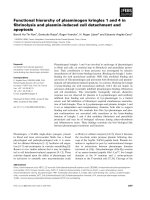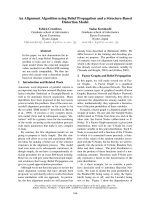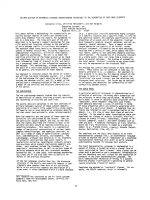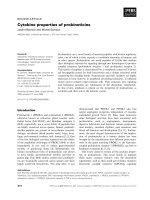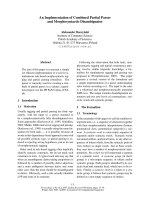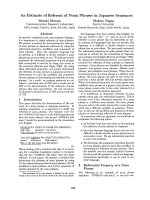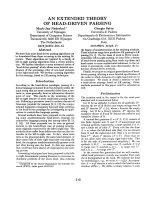Báo cáo khoa học: "An Implementation of Combined Partial Parser and Morphosyntactic Disambiguator" pptx
Bạn đang xem bản rút gọn của tài liệu. Xem và tải ngay bản đầy đủ của tài liệu tại đây (109.09 KB, 6 trang )
Proceedings of the ACL 2007 Student Research Workshop, pages 13–18,
Prague, June 2007.
c
2007 Association for Computational Linguistics
An Implementation of Combined Partial Parser
and Morphosyntactic Disambiguator
Aleksander Buczy
´
nski
Institute of Computer Science
Polish Academy of Sciences
Ordona 21, 01-237 Warszawa, Poland
Abstract
The aim of this paper is to present a simple
yet efficient implementation of a tool for si-
multaneous rule-based morphosyntactic tag-
ging and partial parsing formalism. The
parser is currently used for creating a tree-
bank of partial parses in a valency acquisi-
tion project over the IPI PAN Corpus of Pol-
ish.
1 Introduction
1.1 Motivation
Usually tagging and partial parsing are done sep-
arately, with the input to a parser assumed to
be a morphosyntactically fully disambiguated text.
Some approaches (Karlsson et al., 1995; Schiehlen,
2002; Müller, 2006) interweave tagging and parsing.
(Karlsson et al., 1995) is actually using the same for-
malism for both tasks — it is possible, because all
words in this dependency-based approach come with
all possible syntactic tags, so partial parsing is re-
duced to rejecting wrong hypotheses, just as in case
of morphosyntactic tagging.
Rules used in rule-based tagging often implicitly
identify syntactic constructs, but do not mark such
constructs in texts. A typical such rule may say that
when an unambiguous dative-taking preposition is
followed by a number of possibly dative adjectives
and a noun ambiguous between dative and some
other case, then the noun should be disambiguated
to dative. Obviously, such a rule actually identifies
a PP and some of its structure.
Following the observation that both tasks, mor-
phosyntactic tagging and partial constituency pars-
ing, involve similar linguistic knowledge, a for-
malism for simultaneous tagging and parsing was
proposed in (Przepiórkowski, 2007). This paper
presents a revised version of the formalism and
a simple implementation of a parser understanding
rules written according to it. The input to the rules
is a tokenised and morphosyntactically annotated
XML text. The output contains disambiguation an-
notation and two new levels of constructions: syn-
tactic words and syntactic groups.
2 The Formalism
2.1 Terminology
In the remainder of this paper we call the smallest in-
terpreted unit, i.e., a sequence of characters together
with their morphosyntactic interpretations (lemma,
grammatical class, grammatical categories) a seg-
ment. A syntactic word is a non-empty sequence of
segments and/or syntactic words. Syntactic words
are named entities, analytical forms, or any other se-
quences of tokens which, from the syntactic point of
view, behave as single words. Just as basic words,
they may have a number of morphosyntactic inter-
pretations. By a token we will understand a segment
or a syntactic word. A syntactic group (in short:
group) is a non-empty sequence of tokens and/or
syntactic groups. Each group is identified by its syn-
tactic head and semantic head, which have to be to-
kens. Finally, a syntactic entity is a token or a syn-
tactic group; it follows that syntactic groups may be
defined as a non-empty sequence of entities.
13
2.2 The Basic Format
Each rule consists of up to 4 parts: Match describes
the sequence of syntactic entities to find; Left and
Right — restrictions on the context; Actions —
a sequence of morphological and syntactic actions
to be taken on the matching entities.
For example:
Left:
Match: [pos~~"prep"][base~"co|kto"]
Right:
Actions: unify(case,1,2);
group(PG,1,2)
means:
• find a sequence of two tokens such that
the first token is an unambiguous preposition
([pos~~"prep"]), and the second token is
a possible form of the lexeme CO ‘what’ or KTO
‘who’ ([base~"co|kto"]),
• if there exist interpretations of these two tokens
with the same value of case, reject all interpre-
tations of these two tokens which do not agree
in case (cf. unify(case,1,2));
• if the above unification did not fail, mark
thus identified sequence as a syntactic group
(group) of type PG (prepositional group),
whose syntactic head is the first token (1) and
whose semantic head is the second token (2;
cf. group(PG,1,2));
Left and Right parts of a rule may be empty;
in such a case the part may be omitted.
2.3 Left, Match and Right
The contents of parts Left, Match and Right
have the same syntax and semantics. Each of them
may contain a sequence of the following specifica-
tions:
• token specification, e.g., [pos~~"prep"] or
[base~"co|kto"]; these specifications ad-
here to segment specifications of the Poliqarp
(Janus and Przepiórkowski, 2006) corpus
search engine; in particular there is a distinc-
tion between certain and uncertain information
— a specification like [pos~~"subst"]
says that all morphosyntactic interpretations
of a given token are nominal (substantive),
while [pos~"subst"] means that there ex-
ists a nominal interpretation of a given token;
• group specification, extending the Poliqarp
query as proposed in (Przepiórkowski, 2007),
e.g., [semh=[pos~~"subst"]] specifies a
syntactic group whose semantic head is a token
whose all interpretations are nominal;
• one of the following specifications:
– ns: no space,
– sb: sentence beginning,
– se: sentence end;
• an alternative of such sequences in parentheses.
Additionally, each such specification may be modi-
fied with one of the three standard regular expression
quantifiers: ?,
*
and +.
An example of a possible value of Left, Match
or Right might be:
[pos~"adv"] ([pos~~"prep"]
[pos~"subst"] ns? [pos~"interp"]?
se | [synh=[pos~~"prep"]])
2.4 Actions
The Actions part contains a sequence of mor-
phological and syntactic actions to be taken when
a matching sequence of syntactic entities is found.
While morphological actions delete some interpre-
tations of specified tokens, syntactic actions group
entities into syntactic words or syntactic groups. The
actions may also include conditions that must be sat-
isfied in order for other actions to take place, for ex-
ample case or gender agreement between tokens.
The actions may refer to entities matched by
the specifications in Left, Match and Right by
numbers. These specifications are numbered from
1, counting from the first specification in Left
to the last specification in Right. For example,
in the following rule, there should be case agree-
ment between the adjective specified in the left
context and the adjective and the noun specified
in the right context (cf. unify(case,1,4,5)),
as well as case agreement (possibly of a different
case) between the adjective and noun in the match
(cf. unify(case,2,3)).
Left: [pos~~"adj"]
Match: [pos~~"adj"][pos~~"subst"]
14
Right: [pos~~"adj"][pos~~"subst"]
Actions: unify(case,2,3);
unify(case,1,4,5)
The exact repertoire of actions still evolves, but
the most frequent are:
• agree(<cat>, ,<tok>, ) - check
if the grammatical categories (<cat>, )
of entities specified by subsequent numbers
(<tok>, ) agree;
• unify(<cat>, ,<tok>, ) - as
above, plus delete interpretations that do not
agree;
• delete(<cond>,<tok>, ) - delete all
interpretations of specified tokens match-
ing the specified condition (for example
case~"gen|acc")
• leave(<cond>,<tok>, ) - leave only
the interpretations matching the specified con-
dition;
• nword(<tag>,<base>) - create a new
syntactic word with given tag and base form;
• mword(<tag>,<tok>) - create a new syn-
tactic word by copying and appropriately mod-
ifying all interpretations of the token specified
by number;
• group(<type>,<synh>,<semh>) - cre-
ate a new syntactic group with syntactic head
and semantic head specified by numbers.
The actions agree and unify take a vari-
able number of arguments: the initial argu-
ments, such as case or gender, specify
the grammatical categories that should simulta-
neously agree, so the condition agree(case
gender,1,2) is properly stronger than the
sequence of conditions: agree(case,1,2),
agree(gender,1,2). Subsequent arguments of
agree are natural numbers referring to entity spec-
ifications that should be taken into account when
checking agreement.
A reference to entity specification refers to all
entities matched by that specification, so, e.g.,
in case 1 refers to specification [pos~adj]
*
,
unify(case,1) means that all adjectives
matched by that specification must be rid of all
interpretations whose case is not shared by all these
adjectives.
When a reference refers to a syntactic group, the
action is performed on the syntactic head of that
group. For example, assuming that the following
rule finds a sequence of a nominal segment, a multi-
segment syntactic word and a nominal group, the
action unify(case,1) will result in the unifica-
tion of case values of the first segment, the syntactic
word as a whole and the syntactic head of the group.
Match: ([pos~~"subst"] |
[synh=[pos~~"subst"]])+
Action: unify(case,1)
The only exception to this rule is the semantic head
parameter in the group action; when it references
a syntactic group, the semantic, not syntactic, head
is inherited.
For mword and nword actions we assume that
the orthographic form of the created syntactic word
is always a simple concatenation of all orthographic
forms of all tokens immediately contained in that
syntactic word, taking into account information
about space or its lack between consecutive tokens.
The mword action is used to copy and possibly
modify all interpretations of the specified token. For
example, a rule identifying negated verbs, such as
the rule below, may require that the interpretations
of the whole syntactic word be the same as the in-
terpretations of the verbal segment, but with neg
added to each interpretation.
Left: ([pos!~"prep"]|[case!~"acc"])
Match: [orth~"[Nn]ie"][pos~~"verb"]
(ns [orth~"by[m
´
s]?"])?
(ns [pos~~"aglt"])?
Actions: leave(pos~"qub", 2);
mword(neg,3)
The nword action creates a syntactic word with
a new interpretation and a new base form (lemma).
For example, the rule below will create, for a se-
quence like mimo tego,
˙
ze or Mimo
˙
ze ‘in spite of,
despite’, a syntactic word with the base form MIMO
˙
ZE and the conjunctive interpretation.
Match: [orth~"[Mm]imo"]
[orth~"to|tego"]?
(ns [orth~","])? [orth~"
˙
ze"]
Actions: leave(pos~"prep",1);
15
leave(pos~"subst",2);
nword(conj, mimo
˙
ze)
The group(<type>,<synh>,<semh>) ac-
tion creates a new syntactic group, where <type>
is the categorial type of the group (e.g., PG), while
<synh> and <semh> are references to appropriate
token specifications in the Match part. For exam-
ple, the following rule may be used to create a nu-
meral group, syntactically headed by the numeral
and semantically headed by the noun:
Left: [pos~~"prep"]
Match: [pos~"num"][pos~"adj"]
*
[pos~"subst"]
Actions: group(NumG,2,4)
Of course, the rules should be constructed in
such a way that references <synh> and <semh>
refer to specifications of single entities, e.g.,
([pos~"subst"]|[synh=[pos~"subst"]])
but not [case~"nom"]+
3 The Implementation
3.1 Objectives
The goal of the implementation was a combined par-
tial parser and tagger that would be reasonably fast,
but at the same time easy to modify and maintain. At
the time of designing and implementing the parser,
neither the set of rules, nor the specific repertoire of
possible actions within rules was known, hence, the
flexibility and modifiability of the design was a key
issue.
3.2 Input and Output
The parser currently takes as input the version of
the XML Corpus Encoding Standard (Ide et al.,
2000) assumed in the IPI PAN Corpus of Polish
(korpus.pl). The tagset is configurable, there-
fore the tool can be possibly used for other lan-
guages as well.
Rules may modify the input in one of two ways.
Morphological actions may delete certain interpre-
tations of certain tokens; this fact is marked by
the attribute disamb="0" added to <lex> ele-
ments representing these interpretations. On the
other hand, syntactic actions modify the input by
adding <syntok> and <group> elements, mark-
ing syntactic words and groups.
3.3 Algorithm Overview
During the initialisation phase, the parser loads the
external tagset specification and the ruleset, and con-
verts the latter to a set of compiled regular expres-
sions and actions. Then input files are parsed one
by one (for each input file a corresponding output
file containing parsing results is created). To reduce
memory usage, the parsing is done by chunks de-
fined in the input files, such as sentences or para-
graphs. In the remainder of the paper we assume the
chunks are sentences.
During the parsing, a sentence has dual represen-
tation:
1. object-oriented syntactic entity tree, used for
easy manipulation of entities (for example dis-
abling certain interpretations or creating new
syntactic words) and preserving all necessary
information to generate the final output;
2. compact string for quick regexp matching, con-
taining only the informations important for
these rules which have not been applied yet.
The entity tree is initialised as a flat (one level
deep) tree with all leaves (segments and possibly
special entities, like no space, sentence beginning,
sentence end) connected directly to the root. Appli-
cation of a syntactic action means inserting a new
node (syntacting word or group) to the tree, between
the root and a few of the existing nodes. As the pars-
ing processes, the tree changes its shape: it becomes
deeper and narrower.
The string representations is consistently updated
to always represent the top level of the tree (the chil-
dren of the root). Therefore, the searched string’s
length tends to decrease with every action applied
(as opposed to increasing in a naïve implementa-
tion, with single representation and syntactic / dis-
ambiguation markup added). This is not a strictly
monotonous process, as creating new syntactic en-
tities containing only one segment may temporarily
increase the length, but the increase is offset with
the next rule applied to this entity (and generally the
point of parsing is to eventually find groups longer
than one segment).
Morphological actions do not change the shape
of the tree, but also reduce the string representation
16
length by deleting from the string certain interpreta-
tions. The interpretations are preserved in the tree to
produce the final output, but are not interesting for
further stages of parsing.
3.4 Representation of Sentence
The string representation is a compromise between
XML and binary representation, designed for easy,
fast and precise matching, with the use of existing
regular expression libraries.
The representation describes the top level of the
current state of the sentence tree, including only the
informations that may be used by rule matching. For
each child of the tree root, the following informa-
tions are preserved in the string: type (token / group
/ special) and identifier (allowing to find the entity
in the tree in case an action should be applied to it).
The further part of the string depends on the type —
for token it is orthografic forms and a list of interpre-
tations; for group — number of heads of the group
and lists of interpretations of syntactic and semantic
head.
Every interpretation consists of a base form and
a morphosyntactic tag (part of speech, case, gender,
numer, degree, etc.). Because the tagset used in the
IPI PAN Corpus is intended to be human readable,
the morphosyntactic tag is fairly descriptive (long
values) and, on the other hand, compact (may have
many parts ommited, for example when the category
is not applicable to the given part of speech). To
make pattern matching easier, the tag is converted to
a string of fixed width. In the string, each charac-
ter corresponds to one morphological category from
the tagset (first part of speech, then number, case,
gender etc.) as for example in the Czech positional
tag system (Haji
ˇ
c and Hladká, 1997). The charac-
ters — upper- and lowercase letters, or 0 (zero) for
categories non-applicable for a given part of speech
— are assigned automatically, on the basis of the ex-
ternal tagset definition read at initialisation. A few
examples are presented in table 1.
3.5 Rule Matching
The conversion from the Left, Match and Right
parts of the rule to a regular expression over the
string representation is fairly straightforward. Two
exceptions — regular expressions as morphosyntac-
tic category values and the distinction between ex-
IPI PAN tag fixed length tag
adj:pl:acc:f:sup UBDD0C0000000
conj B000000000000
fin:pl:sec:imperf bB00B0A000000
Table 1: Examples of tag conversion between human
readable and inner positional tagset.
istential and universal quantification over interpreta-
tions — will be described in more detail below.
First, the rule might be looking for a token
whose grammatical category is described by a reg-
ular expresion. For example, [gender~"m."]
should match human masculine (m1), animate mas-
culine (m2), and inanimate masculine (m3) to-
kens; [pos~"ppron[123]+|siebie"] should
match various pronouns; [pos!~"num.
*
"]
should match all segments except for main and col-
lective numerals; etc. Because morphosyntactic tags
are converted to fixed length representations, the
regular expressions also have to be converted before
compilation.
To this end, the regular expression is matched
against all possible values of the given category.
Since, after conversion, every value is represented
as a single character, the resulting regexp can use
square brackets to represent the range of possible
values.
The conversion can be done only for attributes
with values from a well-defined, finite set. Since
we do not want to assume that we know all the text
to parse before compiling rules, we assume that the
dictionary is infinite (this is different from Poliqarp,
where dictionary is calculated during compilation of
corpus to binary form). The assumption makes it
difficult to convert requirements with negated orth
or base (for example [orth!~"[Nn]ie"]). As
for now, such requirements are not included in the
compiled regular expression, but instead handled as
an extra condition in the Action part.
Another issue that has to be taken into careful
consideration is the distinction between certain and
uncertain information. A segment may have many
interpretations and sometimes a rule may apply only
when all the interpretations meet the specified con-
dition (for example [pos~~"subst"]), while in
other cases one matching interpretation should be
17
enough to trigger the rule ([pos~"subst"]). The
aforementioned requirements translate respectively
to the following regular expressions:
1
• (<N[^<>]+)+
• (<[^<>]+)
*
(<N[^<>]+)(<[^<>]+)
*
Of course, a combination of existential and universal
requirements is a valid requirement as well, for ex-
ample: [pos~~"subst" case~"gen|acc"]
(all interpretations noun, at least one of them in gen-
itive or accusative case) should translate to:
(<N[^<>]+)
*
(<N.[BD][^<>]+)
(<N[^<>]+)
*
3.6 Actions
When a match is found, the parser runs a sequence
of actions connected with the given rule, described
in 2.4. Each action may be condition, morphologi-
cal action, syntactic action or a combination of the
above (for example unify is both a condition and a
morphological action). The parser executes the se-
quence until it encounters an action which evaluates
to false (for example, unification of cases fails).
The actions affect both the tree and the string rep-
resentation of the parsed sentence. The tree is up-
dated instantly (cost of update is constant or linear
to match lenght), but the string update (cost linear to
sentence length) is delayed until it is really needed
(at most once per rule).
4 Conclusion and Future Work
Althought morphosyntactic disambiguation rules
and partial parsing rules often encode the same lin-
guistic knowledge, we are not aware of any partial
(or shallow) parsing systems accepting morphosyn-
tactically ambiguous input and disambiguating it
with the same rules that are used for parsing. This
paper presents a formalism and a working prototype
of a tool implementing simultaneous rule-based dis-
ambiguation and partial parsing.
Unlike other partial parsers, the tool does not ex-
pect a fully disambiguated input. The simplicity
of the formalism and its implementation makes it
possible to integrate a morphological analyser into
1
< and > were chosen as convenient separators of interpre-
tations and entities, because they should not happen in the input
data (they have to be escaped in XML).
parser and allow a greater flexibility in input for-
mats.
On the other hand, the rule syntax can be extended
to take advantage of the metadata present in the cor-
pus (for example: style, media, or date of publish-
ing). Many rules, both morphological and syntactic,
may be applicable only to specific kinds of texts —
for example archaic or modern, official or common.
References
Jan Haji
ˇ
c and Barbara Hladká. 1997. Tagging of inflec-
tive languages: a comparison. In Proceedings of the
ANLP’9y, pages 136–143, Washington, DC.
Nancy Ide, Patrice Bonhomme, and Laurent Romary.
2000. XCES: An XML-based standard for linguistic
corpora. In Proceedings of the Linguistic Resources
and Evaluation Conference, pages 825–830, Athens,
Greece.
Daniel Janus and Adam Przepiórkowski. 2006. Poliqarp
1.0: Some technical aspects of a linguistic search en-
gine for large corpora. In Jacek Wali
´
nski, Krzysztof
Kredens, and Stanisław Go´zd´z-Roszkowski, editors,
The proceedings of Practical Applications of Linguis-
tic Corpora 2005, Frankfurt am Main. Peter Lang.
F. Karlsson, A. Voutilainen, J. Heikkilä, and A. Anttila,
editors. 1995. Constraint Grammar: A Language-
Independent System for Parsing Unrestricted Text.
Mouton de Gruyter, Berlin.
Frank Henrik Müller. 2006. A Finite State Approach to
Shallow Parsing and Grammatical Functions Annota-
tion of German. Ph. D. dissertation, Universität Tübin-
gen. Pre-final Version of March 11, 2006.
Adam Przepiórkowski. 2007. A preliminary formal-
ism for simultaneous rule-based tagging and partial
parsing. In Georg Rehm, Andreas Witt, and Lothar
Lemnitzer, editors, Datenstrukturen für linguistische
Ressourcen und ihre Anwendungen – Proceedings
der GLDV-Jahrestagung 2007, Tübingen. Gunter Narr
Verlag.
Adam Przepiórkowski. 2007. On heads and coordina-
tion in valence acquisition. In Alexander Gelbukh,
editor, Computational Linguistics and Intelligent Text
Processing (CICLing 2007), Lecture Notes in Com-
puter Science, Berlin. Springer-Verlag.
Michael Schiehlen. 2002. Experiments in German
noun chunking. In Proceedings of the 19th In-
ternational Conference on Computational Linguistics
(COLING 2002), Taipei.
18

